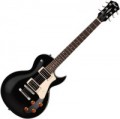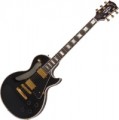Mount type
A method of attaching the neck to the body used in an electric guitar.
—
Boltov. The most inexpensive and practical (in terms of production and repair technology) method of attachment: the neck is bolted to the body. Thanks to this, the assembly of the guitar is extremely simple, and the neck can be easily removed from the finished instrument for repair or even replacement with a new one. Note that although the bolt method is considered “low-cost” (and is found mainly in instruments of the corresponding level), it cannot be said that it is definitely worse than other options: guitars of this design have relatively weak sustain, but they give a bright, sharp tone with good attack. They can be used in almost any genre, but they are still considered the most suitable for heavy music.
—
Pasted. A neck mounted in a recess in the body and secured to the recess with epoxy or other adhesive. This design does not allow for such a powerful attack as on bolt necks, but it provides excellent sustain and a pleasant coloration of the sound. And in general, the adhesive connection is considered more advanced, because. better reveals the acoustic properties of wood. On the other hand, such tools are more complicated and more expensive, both in production and in repair, than “bolted” ones.
—
Through. The name of this method is due to the fact that the neck passes
...through the body through and through, to the “lower” (from the side of the bridge) butt. Many instruments of this type, from the back, look as if two additional pieces were attached to the solid piece of wood from which the neck and middle part of the body were carved to give the body the desired shape and width (although the manufacturing technique is, of course, somewhat more complicated). It is believed that the neck-through mount maximizes the capabilities of the wood and allows you to achieve the highest quality sound, with a flat frequency response and excellent sustain. However, such designs are very expensive, and besides, they require extremely careful handling — especially since the repair of a through neck is at best difficult and expensive, and often impossible at all. Note that this option is used mainly in basses, electric guitars with a through mounting method are produced much less frequently.Neck profile
Profile of a fretboard mounted on an electric guitar.
The profile of the neck is called its shape in section, more precisely, the shape of the back of the neck. This parameter practically does not affect the sound of the guitar, but it directly affects the convenience of playing. Ideally, the neck should “fill” the hand, but not be too large — otherwise it will not be possible to clasp it to the right extent.
Profiles are denoted by the letters C, D, V and U — depending on which letter the neck resembles in the section. Profile D is the flattest, C is slightly more convex, with almost uniform curvature along the entire length, U is more voluminous, with a wider profile in the area of the lining, and the V profile in its classic form has the form of an angle with a rounded top. There are also modifications of these options — for example, "thin", which provides for a reduced profile thickness, or "modern", with slightly improved (theoretically) ergonomics.
The most popular profile types are
C,
U and their "modern" (modern) modifications. The C profile is almost semi-circular, the U profile is more voluminous, at the fingerboard its edges are almost parallel and only closer to the back of the neck are sharply rounded. The terms
modern C and
modern U refer to various improved versions of these profiles, their f
...orm may be different.
In fact, the choice of neck profile depends solely on the guitarist's personal preferences, the characteristics of his hands and his preferred playing technique. Thus, there is no "perfect" profile shape — in each case, the optimal choice will be different. The perfect option is to try several types of profile "live", decide which one will be more convenient, and choose an instrument with a neck of the same or similar profile shape.Nut width
The width of the fretboard of an electric guitar at the nut. Closer to the body, the neck may expand somewhat, but this is not necessary, and the expansion angle may be different. Therefore, the main size is considered to be the width in the region of the nut.
This parameter has two meanings. On the one hand, a wide neck is inconvenient for musicians with small hands and short fingers — it can be difficult to reach the far strings in such cases. On the other hand, a larger width means a greater distance between the individual strings, which reduces the likelihood of hitting an adjacent string when pressed incorrectly and can make playing easier (especially if the guitarist has large fat fingers). However, these moments are not absolute, and the convenience of playing is a very subjective matter, depending on many features of the musician and the technique he uses. Also, don't forget that necks can have different profiles (see above), and instruments with different neck profiles will feel differently in the hands even with the same width at the nut. Therefore, the most reliable method of selection is to try out the necks of different sizes and profiles “live”, decide on the best option and choose based on this.
The smallest neck width at the nut in modern electric guitars is about 39 mm. This size is found mainly in bass guitars (see “Type”), which have 4 strings and a neck that widens noticeably towards the body (due to which it can be made rather narr...ow from above, especially since when playing bass, notes are rarely clamped near the neck itself) . Electric guitars (including semi-acoustic) are somewhat wider — from 41 mm, an indicator of 43 – 48 mm is considered average, and in the largest instruments, the neck can be up to 55 mm wide (however, such dimensions are typical mainly for instruments with more than 6 strings) .
Neck material
The material from which the neck of an electric guitar is made.
The most commonly used in the manufacture of the neck is
mahogany.
and
maple. Theoretically, the acoustic properties of an instrument are determined by all its details, and even more so, these properties are affected by the quality of the fretboard. At the same time, we note that this influence is not so strong compared to other characteristics of the guitar (type and number of pickups, scale size, body type, etc.). So in this case, it makes no sense to describe in detail each type of material found in modern instruments — especially since the same term (for example, “mahogany”) can denote different types of wood that differ markedly in working properties and overall quality. When evaluating the material of the neck, it is quite possible to proceed from the fact that the manufacturer selects it in accordance with the price category and the general specialization of the guitar.
Fretboard
The material from which the fretboard of an electric guitar is made.
The fretboard is placed under the strings, where the strings are pressed when played. The need to use overlays is due to the fact that the types of wood from which the fingerboard itself is made are often not hard enough, and dents could occur on their surface from constant contact with the strings. Accordingly, the overlays are made of a harder material that retains the shape of the surface even after repeated pressing of the strings. As such a material, both special types of wood (
ebony,
rosewood) and high-quality phenolic polymers can be used.
In general, the quality of the fingerboard is usually quite consistent with the price category of the instrument, but it hardly makes sense to dwell on the detailed characteristics of each material (they are not so critical for the normal use of an electric guitar). We only note that the material of the overlay directly affects the appearance of the instrument.

